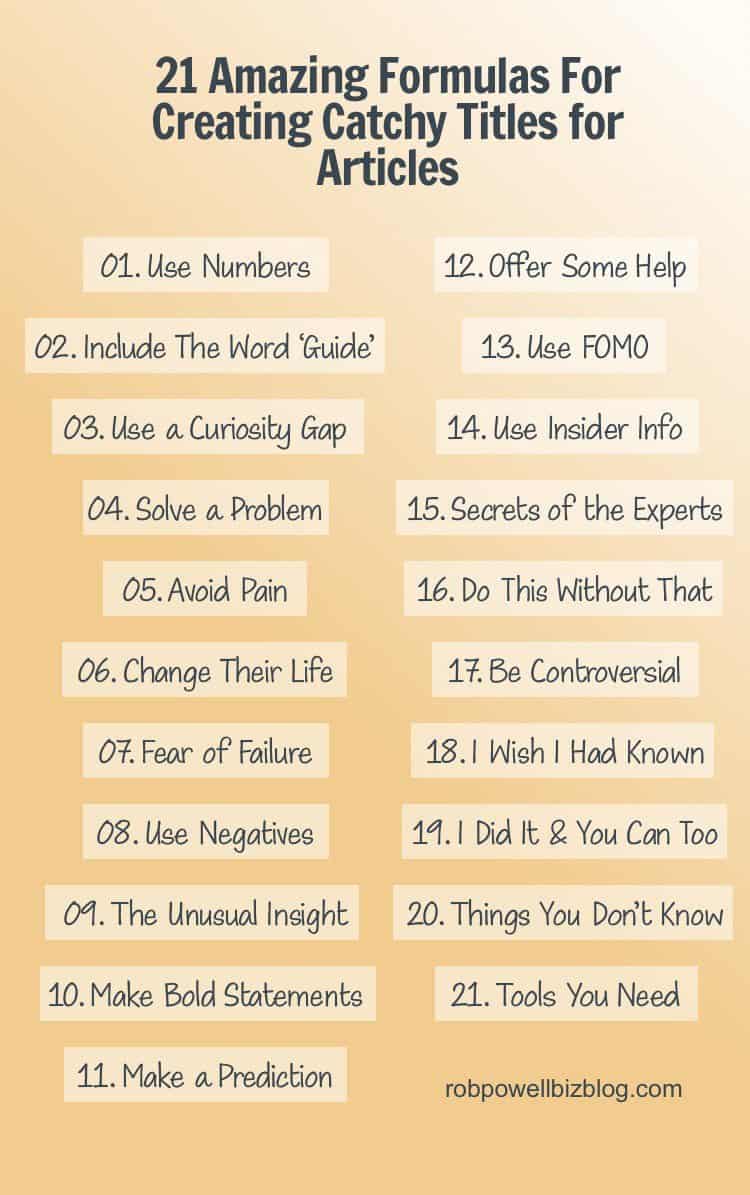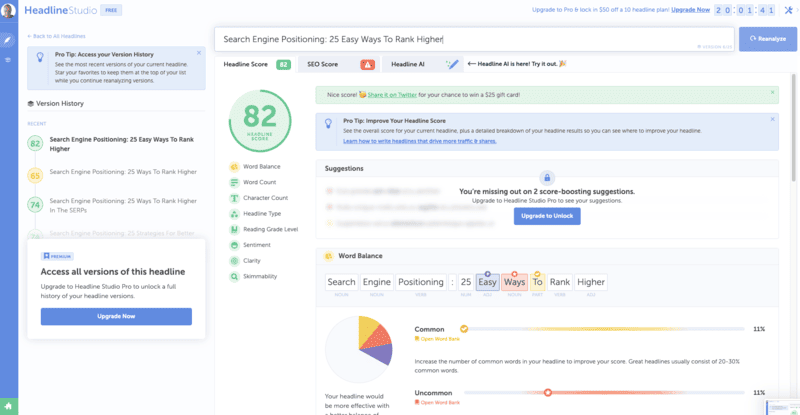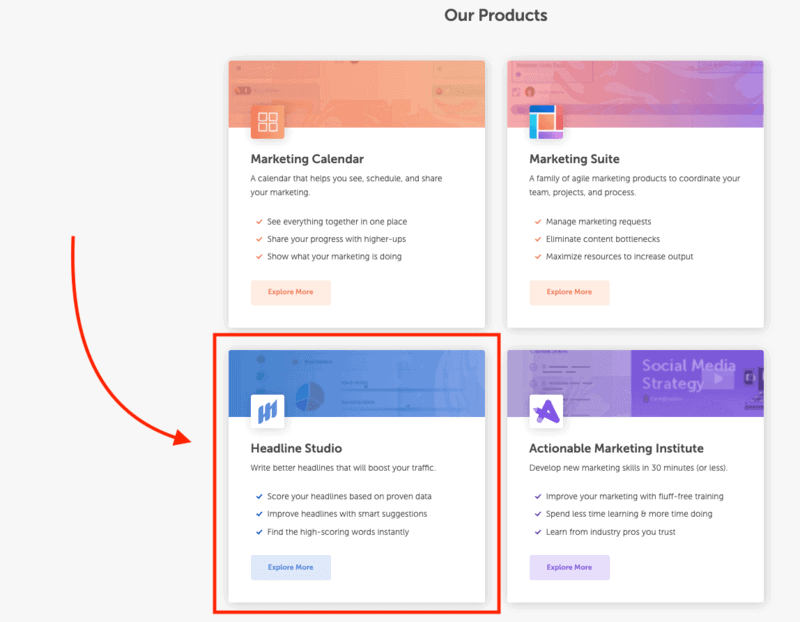Writing catchy titles for articles is a key part of on-page SEO. Catchy article titles result in a higher click-through rate (CTR) from the search results.
This article gives you 21 tried and tested formulas for getting clicks from your blog post titles.
- How To Write Catchy Titles for Articles
- #1. Use Numbers
- #2. Include the Word 'Guide'
- #3. Create a 'Curiosity Gap'
- #4. Titles That Solve a Problem
- #5. Avoidance of Pain
- #6. Promise Change
- #7. Use Fear of Failure
- #8. Use Negatives
- #9. Use The Unusual Insight
- #10. Make Bold Statements
- #11. Make a Prediction
- #12. Offer Help
- #13. Use FOMO
- #14. Use Insider Information
- #15. Use 'Secrets Of The Experts'
- #16. How To Do This Without Doing That
- #17. Be Controversial
- #18. Things I Wish I Had Known
- #19. 'I Did It and So Can You'
- #20. 'Things You Didn't Know'
- #21. Start With The Word 'Why'
- A Tool to Help You Write Better Titles
- Conclusion
- More Articles About Writing
While CTR from the search results may not be a direct ranking signal, it more than likely affects ranking indirectly, as Larry Kim shows in this article.
In a nutshell: the more people who click on your SERP snippet, the higher your page will rank.
And that’s why the SEO title is the most important part of your article.
So how do you write catchy SEO titles?
Here are some examples:
- The 7 Worst ___ Mistakes
- 5 Facts About ___ You Didn’t Know
- Why Everyone is Doing ___ and You Should Too
But let’s look at it in more detail.
In this article, I’m going to show you 21 headline formulas that are used over and over again in online marketing.
Why do people keep using these formulas?
Because they work!
How To Write Catchy Titles for Articles
I’ve spent hours analyzing successful titles to better understand the psychology behind click-worthy headlines. From my research I’ve distilled these 21 formulas that will help you unleash the power of words and make your articles impossible to resist.
So, buckle up and get ready to master the art of writing catchy titles that grab the reader’s attention!
#1. Use Numbers
This is the key ingredient in writing catchy titles for articles: use numbers! Numbers produce order out of chaos (God made the world in 7 days). They also promise something people can read quickly, as in a list post:
- [#] Reasons _____ Is The Best _____
- [#] Ways To _____ With Your Next _____
- The Best [#] Formats For _____
Further Reading: 5 reasons using numbers works in article headlines
#2. Include the Word ‘Guide’
Guides usually cover a topic from A to Z, so the word ‘guide’ suggests your article is authoritative. That’s going to help you get more clicks:
- The Definitive Guide To _____
- The Ultimate Guide To _____
- The Only Guide You’ll Ever Need To _____
#3. Create a ‘Curiosity Gap’
One way to write catchy titles for articles is to create a curiosity gap. A curiosity gap is where your reader is left wondering what something is. Here’s an example:
- 7 Tips For Getting ___ (#3 Will Surprise You)
On one level, you probably know that this is a ploy to get you to click on the link. But on another level, you’re wondering what Tip #3 is: it could be a tip that you’ve never heard before. And there’s only one way to find out – so you click on the link.
Here’s another way of creating a curiosity gap. Whenever you insert the word ‘the’ before a number, it implies that these are not just any tips but very specific tips. Again, the reader wonders what these particular tips are.
Here are some examples (as you read them, try them without the word “the” and you’ll see the difference):
- The [#] _____ Tips That Will Make Your _____
- The [#] _____ That Tripled My _____ in 7 Days
- The One Thing You Need to Know Before Starting a _____
Further Reading: The Curiosity Gap: How to Entice People to Click Your Emails and Read Your Content
#4. Titles That Solve a Problem
When people find your pages in the Google search results, it means they have a problem they’re trying to solve.Use the word ‘How’ in your title and you immediately signal to the reader that you’re about to solve a problem:
- How I Got Rid of _____ Forever With This One Simple Trick
- How To Create Amazing _____ That _____
- How To _____ Even If _____
#5. Avoidance of Pain
Avoidance of pain is an even stronger motivator than the pursuit of pleasure. If your title suggests your reader could avoid loss, cost, or pain, you’ll likely get more clicks:
- Why _____ Could Be You Business’s Biggest Enemy
- Why _____ Could Be Hurting Your ____ and Costing You ____
- [#] Reasons Your _____ Is Turning People Away and Costing You _____
#6. Promise Change
We’re all looking for something that will change our lives. And it doesn’t have to be something huge:
- How _____ Will Change the Way You Think About _____
- The Little-Known Formula That Will Change the Way You _____
- One Simple Technique That Got Me ____ in 7 Days
#7. Use Fear of Failure
One of our greatest motivators is the fear of failure, so if you want to write catchy titles for articles, you should consider invoking fear of failure.Unfortunately, it motivates people more than the desire for success:
- Why Most People Will Never Succeed with ____
- Why Your ____ is Failing and What to Do About It
- Why Your Competitors Are Beating You At ____
MORE ARTICLES ABOUT WRITING
- Best Blog Post Format – 19 Tips for Formatting Online Content
- How To Structure a Blog Post – 13 Elements You Need
- How to Write Your First Blog Post – 17 Tips For Best Results
- How To Write Blog Posts: 10 Best Tips For Ranking on Google
- 21 Great Ideas For Your Next Blog Post
- How To Use Inverted Pyramid Writing for the Web
- How To Write Powerful Titles For Your Blog Posts
- How To Write a Blog Intro (The 4-Step Formula)
- The 7 Most Effective SEO Copywriting Tools For 2022
#8. Use Negatives
You would think we are more attuned to positives than negatives.But the reverse is true: our survival instinct picks up on negatives much quicker than positives. That’s why the newspapers are full of bad news – bad news sells.
Here are some examples:
- What Wikipedia Can’t Tell You About ____
- The [#] Worst ____ Mistakes Of All Time
- When Not to Use ____ On Your ____
Further Reading: New Outbrain Study Says Negative Headlines Do Better Than Positive
#9. Use The Unusual Insight
An unusual insight is where a lesson learned in one field of activity is applied to a completely different field of activity. These kinds of headlines grab people’s attention because they offer a completely new perspective on something.
Here are some examples:
- What The Amish Can Teach You About ____
- [#] Things Sumo Wrestlers Know About ____
- What Cheese Rolling Can Tell You About ____
#10. Make Bold Statements
Bold statements stop people in their tracks and grab their attention.
Here are some examples:
- Why Your ____ Could Be Killing Your Business
- Why ____ Get More ____ Than Any Other ____
- Why ____ Are the Key to Better ____

#11. Make a Prediction
We’re all worried about the future. Even if what we’re doing now is working, will it still work in 5 years’ time?
- Where ____ Is Headed in the Next 5 Years
- The Future of ____ Beyond 2021 – Five Predictions You Need to Know
- [#] Reasons ____ Will Radically Change in The Next 5 Years
#12. Offer Help
We all want to be helped and nurtured. Use the word ‘Help’ in your title.
Here are some examples:
- How ____ Can Help You Write Better ____
- How ____ Can Help Strengthen Your ____
- How ____ Can Help Boost Your ____
#13. Use FOMO
This is a huge trigger for human behavior. Fear of missing out is so basic to human nature that it has its own acronym. FOMO (Fear of Missing Out) is simply the fear that others are getting something you’re not.
Here are some examples:
- Why Everyone is Doing ____ and You Should Too
- Why The Experts Don’t ____ (and You Shouldn’t Either)
- Why The Pros Are Switching to ____
#14. Use Insider Information
We all want to get ‘inside’ information that is not available to the masses. That’s why these kind of titles get masses of clicks:
- [#] Little Known Ways of _____
- [#] Unexpected Ways ____ Can Affect Your _____
- [#] Ways to Get More ____ That Would Probably Never Occur to You
#15. Use ‘Secrets Of The Experts’
Most people believe that experts never share their best secrets, so this is another kind of title that will trigger a response:
- [#] Things About ____ the Experts Won’t Tell You
- [#] Things About ____ the Pros Don’t Want You to Know
- [#] ____ Tips The Experts Are Keeping to Themselves
#16. How To Do This Without Doing That
It’s a fact of life that most of the things we want involve doing something we don’t want, hence the saying: “no pain, no gain”. And that’s why this kind of title has such a strong appeal – it promises the result without the pain. This title formula takes the form of ‘How To Do This (Positive Thing) Without Doing That (Negative Thing)’.
This technique has the added benefit that it allows you to include a secondary keyword in your title:
- How to Remove ____ Without Risking ____
- How to Get More ____ Without Spending a Dime on ____
- How To ____ Without Feeling Like a Fraud
#17. Be Controversial
The Internet is swamped with free content that basically regurgitates advice that’s already available in hundreds of different blog posts. And that’s why controversial or contradictory titles get clicks. You’re telling the reader: “This is something different”. Here are some examples:
- Why Most ____ Experts Are Wrong About the Future of ____
- The Big Mistake Most ____ Make Every Time They Hit ‘Publish’
- [#] Reasons I Don’t ____ Anymore
#18. Things I Wish I Had Known
We all know that learning from other’s mistakes can save us months, if not years, of frustration. So this is another type of title that people click on:
- [#] Things I Wish Somebody Had Told Me When I Started ____
- [#] Things About ____ I Wish I Had Known Before I Got ____
- [#] Things I Wish I Had Known When I Started My ____
#19. ‘I Did It and So Can You’
One of the fears that people have on the Internet, especially when they are starting out, is that the people giving advice are successful because they have some advantages that the reader doesn’t have. So if you can assure people in the title that they can get the same result you did, that’s going to get clicks.
Here are some examples:
- How I Got _____ And You Can Too
- How I Amassed 50K Followers on ____ and So Can You
- How I Got Published on ____ (& You Can Too)
#20. ‘Things You Didn’t Know’
When people read a title, they’re trying to decide (in a split second) if this is information they already have. And that’s why this kind of title gets so many clicks. Because you’re telling them, upfront, that this is information they definitely don’t have.
Here are some examples:
- [#] Facts About ____ You Didn’t Know
- [#] Strategies You Didn’t Know for Getting People to ____
- [#] Techniques You Never Heard of For Getting More ____
#21. Start With The Word ‘Why’
When you begin your title with the word ‘why’, it tells the reader you’re about to give them a reason. And reasons have a powerful effect on human beings.
In 1977, American professor of psychology, Ellen Langer, conducted an experiment where she got students to jump the queue for a photocopy machine. The students gave three different reasons for jumping the queue:
- Version 1 (request only): “Excuse me, I have 5 pages. May I use the Xerox machine?”
- Version 2 (request with a real reason): “Excuse me, I have 5 pages. May I use the xerox machine, because I’m in a rush?”
- Version 3 (request with a fake reason): “Excuse me, I have 5 pages. May I use the xerox machine, because I have to make copies?”
It was version #3 (which is not actually a reason) that was the most successful in getting people to agree to the queue jumping.The takeaway? Reasons are so powerful in human psychology that even a meaningless reason will work. You can read more about this experiment in James Clear’s article: The One Word That Drives Senseless and Irrational Habits.
- Why You Should Avoid Selling Your Home ‘As Is’
- Why Too Much Praise Could Be Ruining Your Child
- Why You Shouldn’t Invest in Bitcoin, Even If The Price Is Surging
A Tool to Help You Write Better Titles
If you want help writing your headlines, try Co-Schedule’s Headline Studio.
This is a powerful content marketing tool designed to help you create compelling and engaging headlines for your online content. Whether you’re writing a blog post, social media updates, email subject lines or any other form of digital content, Headline Studio will help you craft attention-grabbing headlines that resonate with your audience.
There’s a paid version and a free version but the free version works just fine.

Headline Studio evaluates your headline based on various factors such as word balance, length, sentiment, and emotional appeal. It provides a score and suggestions for improving your headline to make it more captivating and attention-grabbing.
I’ve been using it for a couple of years – I find it a great way to get the juices flowing.
Start off by typing in your basic title (don’t worry if it’s not very good – the tool will tell you how to improve it).
Then just keep following the suggestions until you get a score in the 80’s. And then you’re good to go!
To access Headline Studio click on the link below and then scroll down to ‘Our Products’ and click on ‘Headline Studio’:
Co-Schedule’s Headline Studio (free tool for writing better headlines)

Conclusion
The title of your article has a huge impact on whether people click on your snippet in the search results. Yet for many bloggers, the title of their blog post is an afterthought. Titles make or break your articles. And that’s why it’s worth spending some time writing a compelling title.
Try using just some of these title formulas on your next blog post and watch as it rises up the search results.
And if you’ve got a moment, go back to your old blog posts and see if you can use these formulas to come up with better titles for them as well.
More Articles About Writing
- Best Blog Post Format – 19 Tips for Formatting Online Content
- How To Structure a Blog Post – 13 Elements You Need
- How to Write Your First Blog Post – 17 Tips For Best Results
- How To Write Blog Posts: 10 Best Tips For Ranking on Google
- 21 Great Ideas For Your Next Blog Post
- How To Use Inverted Pyramid Writing for the Web
- How To Write Powerful Titles For Your Blog Posts – The Complete Guide
- How To Write a Blog Intro (The 4-Step Formula That Pulls Readers In)
- The 7 Most Effective SEO Copywriting Tools For 2022
Excellent !
Really amazing tips, appreciate clarity explanation and excellent examples. Must read before before finalizing title to their articles.
Mahesh Hegde
I like how you mentioned that people can read numbers quickly in news titles. My brother is wanting to become a news reporter and he was wondering how he can make intriguing titles for his job. I’ll be sure to tell him to make news article titles with numbers in them.
Thanks, glad it was useful – Rob
Thanks, Mahesh, glad it was useful – Rob